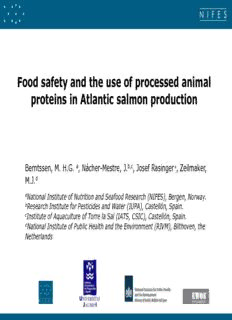
Food safety and the use of processed animal proteins in Atlantic salmon production PDF
Preview Food safety and the use of processed animal proteins in Atlantic salmon production
Food safety and the use of processed animal proteins in Atlantic salmon production Berntssen, M. H.G. a, Nácher-Mestre, J.b,c, Josef Rasingera, Zeilmaker, M.J.d aNational Institute of Nutrition and Seafood Research (NIFES), Bergen, Norway. bResearch Institute for Pesticides and Water (IUPA), Castellón, Spain. cInstitute of Aquaculture of Torre la Sal (IATS, CSIC), Castellón, Spain. dNational Institute of Public Health and the Environment (RIVM), Bilthoven, the Netherlands Introduction salmon farming Norwegian aquaculture of salmonids 2015 Salmonids in Norway: 1.386.575 mt • Using in total 1 663 890 mt feed in Norway – Fish meal and oil are traditionally the main feed ingredient to carnivorus fish such as salmon • Use of wild pelagic fish species, such as blue whiting, to produce fish meal and oil which are included in high energy salmon diets • Net importer of fish meal and fish oil Introduction salmon farming Sustainability in salmon farming Recent trends - using more alternative ingredients towards balance in the ”Fish in–fish out” concept (FIFO) Wild fish used per kg salmon produced 1995 2005 2006 2007 2010 2015 2020 Salmon 7.5 5.4 4.9 4.0 3.0 2.0 1.5 All species 1.0 0.9 0.7 0.6 0.5 0.3 0.2 (Tacon & Metian 2008) • In EU projects, RAFOA, AQUAMAX, ARRAINA – “Production of one 1kg of Atlantic salmon on this diet required 800g of wild fish resources (Fish in - Fish out<1)”. (Lilland et al. 2013. Aquacult. Nutr. 289-300) Introduction salmon farming Aquaculture grows while fish oil & meal availability stays the same Replacement of fish oil and meal with plant ingredients ? Rapeseed Soya protein PAP back into the seafood web again… • EU re-authorization of the use of non-ruminant processed animal proteins in animal feeds, initially for aquafeeds • Represents large and flexible resources for fish feed which does not require new production of ingredients Plant oil and meal Fish oil and meal Marine Harvest rapport ”Sustainable seafood” (2010) Earlier Norwegian research council ABP project and publications; PAPs are suited feed ingredients with nutrition values for Atlantic salmon Diet 1: control: fish meal and oil Diet 2: Poulty meal and pork blood meal 1,2 Diet 3: poultry oil Diet 4: Poulty meal and pork blood meal+poultry o*il 1 0,8 Control Animal protein 0,6 Animal oil 0,4 Animal protein and oil 0,2 0 FI, %/d SGR, %/d FCR (feed:gain) Digestibility (%) of some nutrients Diet 1: control: fish meal and oil Diet 2: Poulty meal and pork blood meal Diet 3: poultry oil Diet 4: Poulty meal and pork blood meal+poultry oil Control 100 Animal protein Animal oil 95 Animal protein and oil % 90 , C D 85 A 80 75 Nitrogen Total AA Crude fat Norwegian Research Council project; “Food safety and the use of terrestrial animal by-products in Atlantic salmon production” 2013-2017 • New feed ingredients give new challenges to feed safety and legislative compliance • The project aims to assess feed and food safety of farmed salmon reared on PAP-feed. Project outline WP 1. Species (non ruminant)/tissue specific identification PAPs, see poster Josef Rasinger WP 3. Carry-over WP 2. Screening therapeutically chemical undesirables substances Feed-to-fillet
Description: